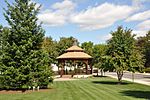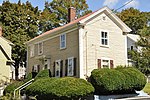Haywardville, Massachusetts
In the early 1800s, Nathaniel Hayward bought remodeled shoe mills in Stoneham, Massachusetts from Elisha Converse, founder of the largest rubber shoe manufacturer in the world, the Boston Rubber Shoe Company in Malden, Massachusetts. Straddling Spot Pond Brook, the village was the site of early industrial development which later blossomed into larger factories. The factory grew to be an industrial community that has come to be known as Haywardville. It is here where Hayward and Charles Goodyear invented slickers (canvas and rubber coats) and the process of vulcanization. The factory produced a variety of rubber products including boots, pails and spittoons. There were numerous large factory buildings here during this period, a community of living quarters, some shops - or at least places to barter for goods.
Excerpt from the Wikipedia article Haywardville, Massachusetts (License: CC BY-SA 3.0, Authors).Haywardville, Massachusetts
Whip Hill Road,
Geographical coordinates (GPS) Address Nearby Places Show on map
Geographical coordinates (GPS)
| Latitude | Longitude |
|---|---|
| N 42.464166666667 ° | E -71.091388888889 ° |
Address
Whip Hill Road
Whip Hill Road
02180
Massachusetts, United States
Open on Google Maps











